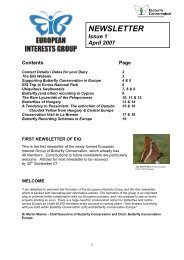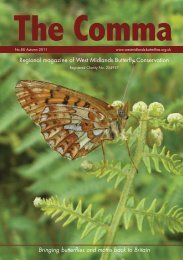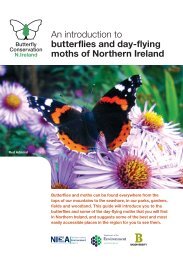Spring 2012 newsletter - Butterfly Conservation
Spring 2012 newsletter - Butterfly Conservation
Spring 2012 newsletter - Butterfly Conservation
Create successful ePaper yourself
Turn your PDF publications into a flip-book with our unique Google optimized e-Paper software.
The Trials of a White-letter Hairstreak Douglas Goddard<br />
The White-letter Hairstreak had a<br />
good season in 2011. Observers sent<br />
in records of larvae found on Wych<br />
Elm in Daventry and Boughton,<br />
the adults were seen from 10th June<br />
until 28th July, and several new sites<br />
were discovered, notably Wicksteed<br />
Park.<br />
In Fermyn Wood, there are a<br />
number of elm trees, some of which<br />
provide sightings of White-letters<br />
reliably each year. One lies at a ride intersection<br />
in Cherry Lap, and here, at the beginning of July,<br />
pupae were to be found under the leaves and good<br />
numbers of the adults were emerging and laying<br />
eggs. Commas also use the tree as a foodplant and<br />
their larvae were also easy to find here.<br />
The dark pupa<br />
While searching and photographing Comma<br />
larvae on 4th July, a White-letter pupa was still to<br />
be seen, long after the emergence of others. Dark<br />
brown in colour, it had clearly been parasitized<br />
and was not going to hatch. I decided to take it<br />
home to note further developments. A<br />
week later, sure enough, a small wasp<br />
emerged from the pupa, sawing off<br />
the end to make its exit. I photographed<br />
the specimen and sent it to Mark Shaw at<br />
Edinburgh. He identified it as a female of<br />
Virgichneumon tergenus (right), a known,<br />
6<br />
but rarely collected, parasitoid<br />
of the White-letter. It attacks the<br />
host in the pupal or prepupal state,<br />
so is only found in pupae. It has<br />
been reared from Black Hairstreak<br />
(Perkins’ Royal Entomological<br />
Society Handbook), and the<br />
National Museum of Scotland has<br />
specimens from Silver-studded<br />
Blue, Common Blue, satyrium<br />
esculi (from Spain) and three from<br />
White-letter Hairstreak, including<br />
mine. The hibernating strategy of this wasp is<br />
not known; if it, presumably, over-winters as an<br />
adult, only the female will do this, having mated<br />
beforehand.<br />
On 1st October, Andy Wyldes and I visited the wood<br />
again, looking (unsuccessfully!) for Purple Emperor<br />
larvae. As we walked through Cherry lap, the work<br />
of the Forestry Commission was much in evidence,<br />
the lower branches of sallows and other trees having<br />
been hacked away by mechanical cutters to make the<br />
route clear for lorry access. Our favourite elm had<br />
not been spared this destruction, several of the lower<br />
branches lying in a heap on the ground. We searched<br />
the branches and found a couple of eggs and cleared<br />
the remaining ones into a heap to look through<br />
later. That evening I took a few of them home and<br />
searched them, discovering eight more eggs. Closer<br />
inspection revealed that three of these had exit holes<br />
made by another parasitoid, a tiny wasp. The rest<br />
will be kept and hopefully reared in the spring to<br />
be released as adults, along with any others we find<br />
among the remaining branches later on.<br />
Predation of butterflies in their early stages is<br />
widespread, and these discoveries serve to remind<br />
us that it can be extensive in some years. Of a<br />
hundred eggs laid by a female butterfly, only<br />
two must survive to adulthood, to replace the<br />
original pair which mated and keep the<br />
population level stable, so normally species







